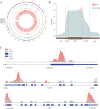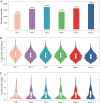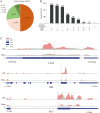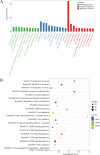Epitranscriptomic profiling of N6-methyladenosine-related RNA methylation in rat cerebral cortex following traumatic brain injury
- PMID: 31992337
- PMCID: PMC6986156
- DOI: 10.1186/s13041-020-0554-0
Epitranscriptomic profiling of N6-methyladenosine-related RNA methylation in rat cerebral cortex following traumatic brain injury
Abstract
Background: N6-methyladenosine (m6A) is the most prevalent post-transcriptional modification of eukaryotic mRNA. It has been reported that there is a stimulus-dependent regulation of m6A in the mammalian central nervous system in response to sensory experience, learning, and injury. The mRNA m6A methylation pattern in rat cortex after traumatic brain injury (TBI) has not been investigated.
Results: In this study, we conducted a genome-wide profiling of mRNA m6A methylation in rat cortex via methylated RNA immunoprecipitation sequencing (MeRIP-Seq). After TBI, the expressions of METTL14 and FTO were significantly down-regulated in rat cerebral cortex. Using MeRIP-Seq, we identified a total of 2165 significantly changed peaks, of which 1062 were significantly up-regulated and 1103 peaks were significantly down-regulated. These m6A peaks were located across 1850 genes. The analysis of both m6A peaks and mRNA expression revealed that there were 175 mRNA significantly altered methylation and expression levels after TBI. Moreover, it was found that functional FTO is necessary to repair neurological damage caused by TBI but has no effect on the spatial learning and memory abilities of TBI rats by using FTO inhibitor FB23-2.
Conclusion: This study explored the m6A methylation pattern of mRNA after TBI in rat cortex and identified FTO as possible intervention targets in the epigenetic modification of TBI.
Keywords: Epigenetic modification; FTO; Rat cortex; Traumatic brain injury; m6A methylation.
Conflict of interest statement
The authors declare that they have no competing interests.
Figures









Similar articles
-
Genome-wide analysis of lncRNA m6A methylation in the mouse cortex after repetitive mild traumatic brain injury.BMC Genomics. 2025 May 20;26(1):509. doi: 10.1186/s12864-025-11696-6. BMC Genomics. 2025. PMID: 40394496 Free PMC article.
-
Genome-wide screening of altered m6A-tagged transcript profiles in the hippocampus after traumatic brain injury in mice.Epigenomics. 2019 May;11(7):805-819. doi: 10.2217/epi-2019-0002. Epub 2019 Mar 18. Epigenomics. 2019. PMID: 30882247
-
Comprehensive Analysis of Differential m6A RNA Methylomes in the Hippocampus of Cocaine-Conditioned Mice.Mol Neurobiol. 2021 Aug;58(8):3759-3768. doi: 10.1007/s12035-021-02363-4. Epub 2021 Apr 7. Mol Neurobiol. 2021. PMID: 33826069
-
Epigenetic regulation of mRNA N6-methyladenosine modifications in mammalian gametogenesis.Mol Hum Reprod. 2021 May 8;27(5):gaab025. doi: 10.1093/molehr/gaab025. Mol Hum Reprod. 2021. PMID: 33823008 Review.
-
Role of N6-methyladenosine modification in pathogenesis of ischemic stroke.Expert Rev Mol Diagn. 2022 Mar;22(3):295-303. doi: 10.1080/14737159.2022.2049246. Epub 2022 Mar 8. Expert Rev Mol Diagn. 2022. PMID: 35236212 Review.
Cited by
-
N6-methyladenosine RNA is modified in the rat hippocampus following traumatic brain injury with hypothermia treatment.Front Neurosci. 2023 Feb 15;17:1069640. doi: 10.3389/fnins.2023.1069640. eCollection 2023. Front Neurosci. 2023. PMID: 36875640 Free PMC article.
-
Downregulation of m6A Methyltransferase in the Hippocampus of Tyrobp -/- Mice and Implications for Learning and Memory Deficits.Front Neurosci. 2022 Mar 21;16:739201. doi: 10.3389/fnins.2022.739201. eCollection 2022. Front Neurosci. 2022. PMID: 35386591 Free PMC article.
-
Research Progress on the Role of RNA m6A Modification in Glial Cells in the Regulation of Neurological Diseases.Biomolecules. 2022 Aug 21;12(8):1158. doi: 10.3390/biom12081158. Biomolecules. 2022. PMID: 36009052 Free PMC article. Review.
-
Comprehensive analysis of N6-methyladenosine (m6A) modification during the degeneration of lumbar intervertebral disc in mice.J Orthop Translat. 2021 Dec 15;31:126-138. doi: 10.1016/j.jot.2021.10.008. eCollection 2021 Nov. J Orthop Translat. 2021. PMID: 34976732 Free PMC article.
-
Epitranscriptomic regulation by m6A RNA methylation in brain development and diseases.J Cereb Blood Flow Metab. 2020 Dec;40(12):2331-2349. doi: 10.1177/0271678X20960033. Epub 2020 Sep 23. J Cereb Blood Flow Metab. 2020. PMID: 32967524 Free PMC article. Review.
References
MeSH terms
Substances
LinkOut - more resources
Full Text Sources
Medical

